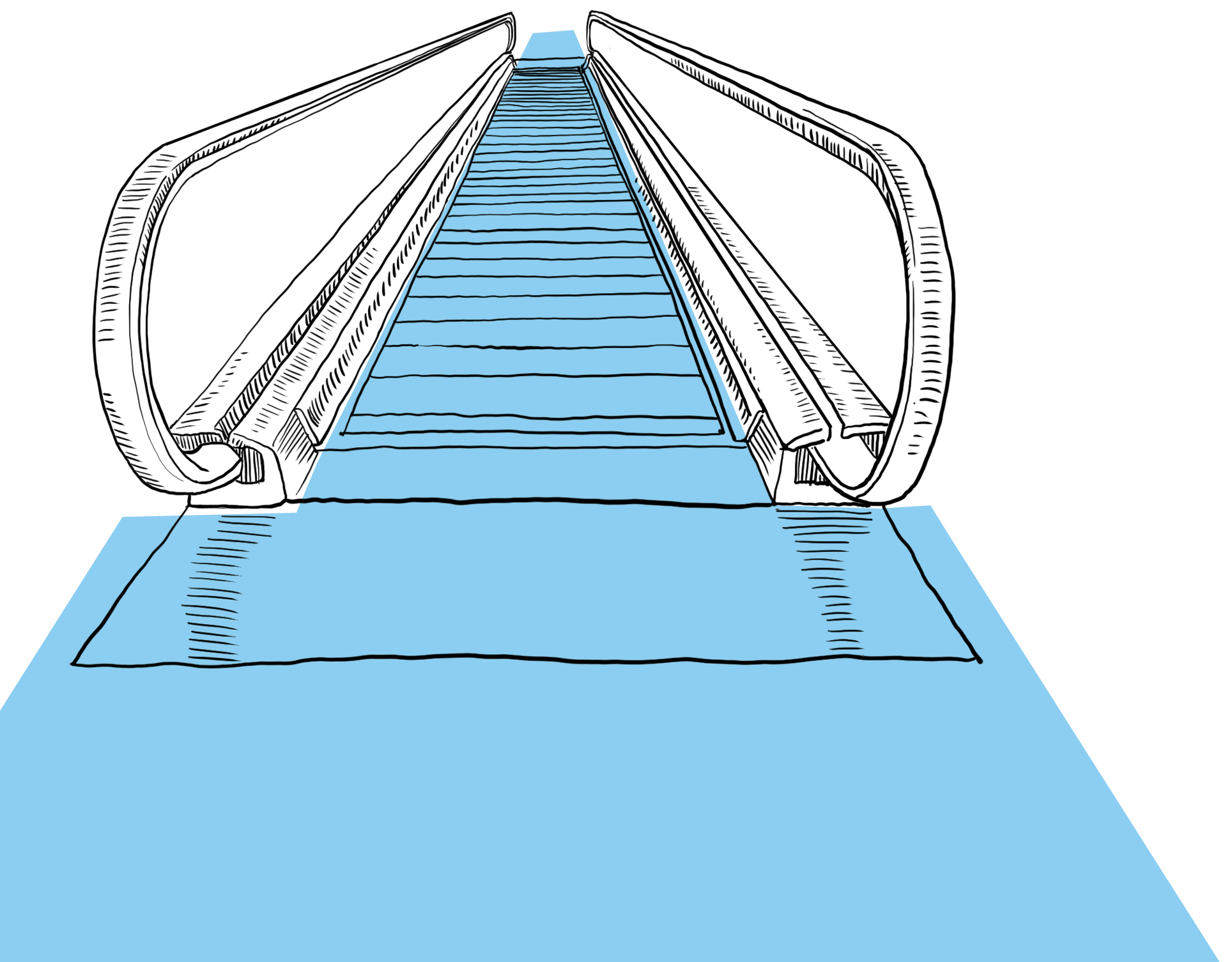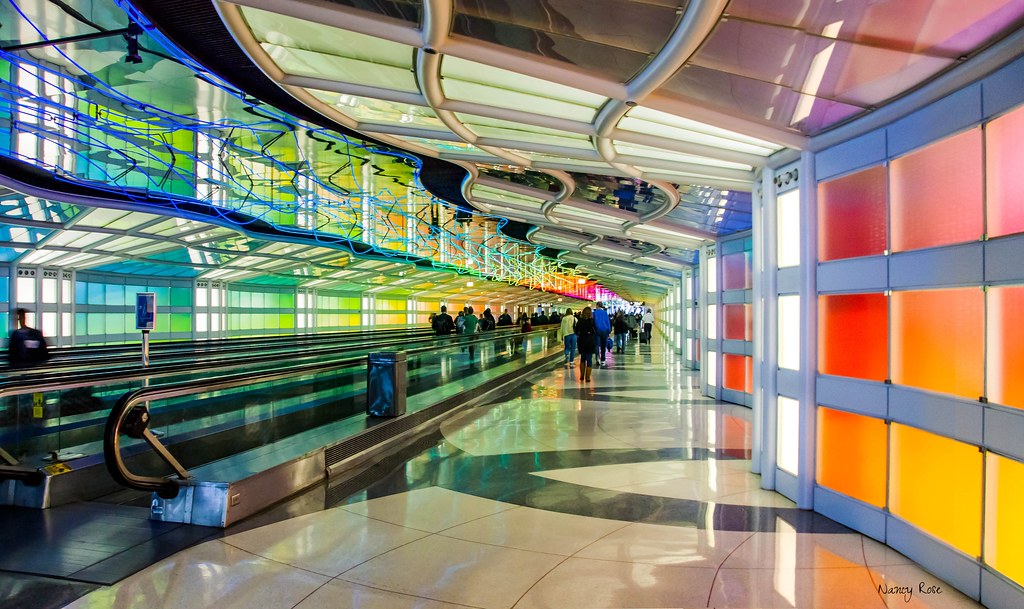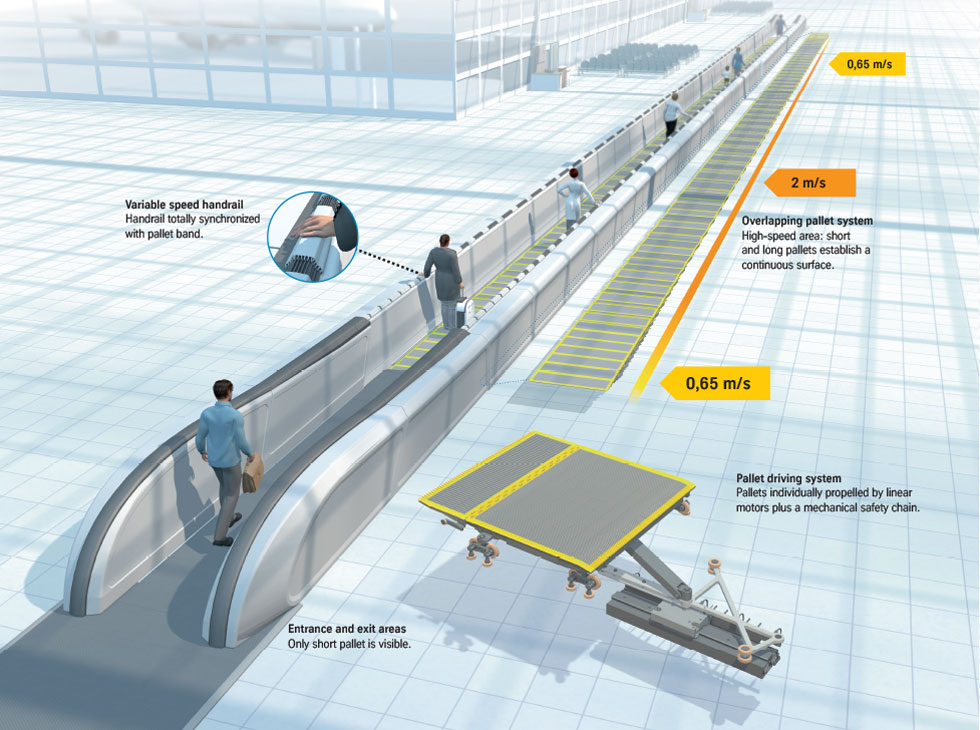Moving
Walkway

Moving walkways are a particularly effective tactic of guiding passenger movement, and achieving directional crowd control.
︎︎︎ Related entries:
Floors
Departure Hall
Passageways
︎ Random Entry
Tags: airport design, wayfinding,
spatial configuration, directionality
Floors
Departure Hall
Passageways
︎ Random Entry
Tags: airport design, wayfinding,
spatial configuration, directionality
Design Decisions
A moving walkway, also known as a travelator, is a moving conveyor belt system that transports people across a horizontal or inclined plane over a distance. They are usually installed in pairs, one for each direction, and commonly 3 to 4 feet wide to accommodate either a person with luggage, or two people standing side by side. These moving walkways are common in passageways between concourses and the terminal, and especially long concourses.
 Travelator and
method for controlling
Travelator and
method for controlling
the operation
Most airports today use walkways that move at a slower speed than a natural walking pace, so using the walkways only minimally expedites travel times. These moving walkways travel at about half the speed (1.4 mph) of a natural walking pace (3 mph). Studies have calculated that passengers on walkways move on average at a speed of 3.66 mph, only nominally faster than the normal walk speed at an airport of 3 mph [1, 2].
 A proposal for a comb system
for acceleration
and deceleration of
passengers
A proposal for a comb system
for acceleration
and deceleration of
passengersMoving walkways have changed very little in the last 100 years, but there have been a few high-profile attempts at developing high-speed walkways in both airports and other public urban settings, to varying success. In 2002, CNIM installed the experimental 607 ft high-speed moving walkway in a metro station in France, which operated at a speed of 7.5 mph at first, and later was reduced to 5.6 mph due to safety concerns. It required a 33-feet long acceleration zone, and many users lost their balance. Eventually, it was abandoned in 2009 [3]. In 2007, ThyssenKrupp installed two high-speed walkways in Toronto Pearson Airport, which operates at an initial speed of 1.2 mph, speeds up to 4.3 mph, and slows back down to 1.2 mph [4]. It uses a pallet-type design which accelerates and decelerates users more naturally and mitigates many of the issues raised by CNIM’s earlier version.
Effects on Passengers
As many large airports undergo renovations in recent years, airport designers have been deliberating whether to keep or remove moving walkways [5]. One argument for removing them is that the walkways do not significantly increase speed for the passengers, and that they take up valuable space that could be used for retail and food stores and generate further revenue.
However, moving walkways generally remain popular among passengers. For most, moving walkways invoke delight as passengers can stand still and allow the walkway to transport them with no effort. As most passengers travel with heavy luggage in tow, moving walkways can also provide a brief respite, and they are especially a boon for elderly travelers with reduced mobility.
For airports, these walkways are an effective strategy of directional crowd control [6]. It prevents congestations and gridlocks in busy passageways because it keeps passengers moving in one direction, and provides a mental and visual separation of sides of the corridor as the “fast lane” and a “slow lane”.
 "Sky’s the Limit" kinetic light sculpture at Chicago O'Hare Airport uses Artwork tactic to emphasize directionality and movement of the walkway.
"Sky’s the Limit" kinetic light sculpture at Chicago O'Hare Airport uses Artwork tactic to emphasize directionality and movement of the walkway. What-Ifs


Diagrams of CNIM’s high speed travelator (above) and of ThyssenKrupp’s highspeed travelator (below)
- Young, Seth, B. “Evaluation of pedestrian walking speeds in airport terminals,” Transp. Res. Rec. 1674, 21 1999 No. 99-0824.
-
Srinivasan, Manoj. “Optimal Speeds for Walking and Running, and Walking on a Moving Walkway.” Chaos: An Interdisciplinary Journal of Nonlinear Science 19, no. 2 (June 2009): 026112.
-
Freemark, Yonah. "Paris Experimental High-Speed Moving Walkway is Abandoned" The Transport Politic. May, 2009.
-
Bryant, Chris. "ThyssenKrupp aims to accelerate travelators beyond the pedestrian". The Financial Times. October, 22, 2014. .
-
Silva, Valerie. “Are Moving Walkways Helping or Hindering Passenger Flow at Airports?” APEX | Airline Passenger Experience, January 16, 2017.
-
“City in the Sky.” PBS. BBC, February 8, 2017.